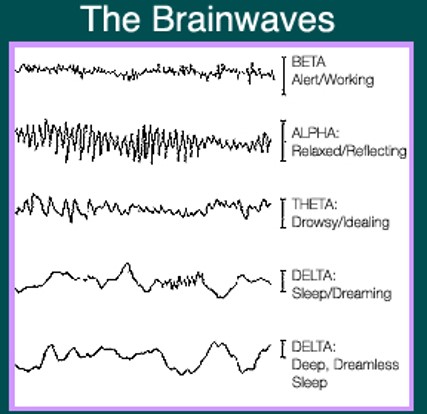Originally published in 1975, Herbert Benson’s “The Relaxation Response” brought a simple, secular version of Transcendental Meditation to people in the Western world.
Meditation, a basic and well-studied contemplative practice, also allows you to become more aware of, familiar with the old self (old thoughts, beliefs and behaviours) even as ground for a new self is cultivated. As simple (and challenging) as focusing on your breath, the inhale and the exhale, these moments of mindful attention provide relaxation and/or observation of what goes on in our mind. The effect of meditation on our brain might be helpful:  You see the four levels of brain waves here from the most active, Beta, into Alpha (relaxed and reflecting) and Theta (drowsy and peaceful) and finally into Delta (sleep).
You see the four levels of brain waves here from the most active, Beta, into Alpha (relaxed and reflecting) and Theta (drowsy and peaceful) and finally into Delta (sleep).
High-range Beta is found during a sustained focus in a high arousal state–situations in which the stress chemicals are released, such as perceived emergencies. While we have been gifted with this amazing survival mechanism, remaining in this state over a prolonged period knocks us far out of balance and requires an immense amount of energy leading to a state of incoherence (scattered thoughts) and continual repetition of survival-based thoughts from fear.
The human mind is about 5% analytical or conscious – the seat of logic and reasoning, which contributes to faith, intentions and creative abilities. The subconscious mind, about 95%, consists of those positive and negative identifications and associations (memories) that give rise to habits and behaviours. Meditation can take us from the survival/analytical mind (Beta) into a place of greater awareness, the subconscious. It is possible to alter your brainwaves from that high-frequency Beta state into Alpha or Theta. As you know, when you close your eyes, your brain has less to think about and analyze from the outside world and the electrical activity in the brain is subdued. The Alpha state serves as the bridge between the conscious mind and the subconscious mind, as the brain slowly shifts into a more orderly and coherent wave pattern and the body shifts out of its emergency protective system of fight/flight/freeze into an internal protection system of growth and repair. Our intention is to let go, let our brain go loose as we allow our breath to flow us into ever slower brain activity. We are now in a place to observe our inner thoughts and feelings as well as being more relaxed and available to change.
Header Image courtesy of Pixabay/Activedia
